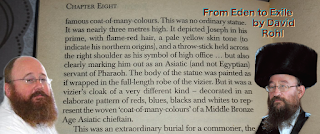Relatives of Senpai Jesus Christ married into the Royal Bloodline
of both European and Arab aristocrats.
It is easier to spot them among Priest class and Rabbinical lineage,
their phenotype are similar
and just one drop of Senpai Jesus Bloodline in a family
is enough to trigger phenotype pop up in the family tree.
Isaiah 60:16 - Thou shall guzzle the milk of the Goyim,
Suckle at the breast of Kings. ( Simp for me ! Simp for Chosenites ! )
Emperors shall be your Foster Daddies
Their Queens thy nursing Mothers
Goys shall bow down to you, face to the ground
Goyim lick up the dust of your feet and you shalt know that I am God
Those who trust in Me shall not be shamed - Isaiah 49:23
Matthew 10:34 Matthew 27:25 Exodus 19:6 Lamentations 4:7 Amos 3:2
1 Samuel 16:12 John 4:22 Genesis 35:11 Isaiah 60:16 Genesis 32:28
=== short version
Relatives of Senpai Jesus Christ married into the Royal Bloodline
of both European and Arab aristocrats - Isaiah 49:23
It is easier to spot them among Priest class and Rabbinical lineage,
their phenotype are similar
and just one drop of Senpai Jesus Bloodline in a family
is enough to trigger phenotype pop up in the family tree.
Matthew 10:34 Matthew 27:25 Exodus 19:6 Lamentations 4:7 Amos 3:2
1 Samuel 16:12 John 4:22 Genesis 35:11 Isaiah 60:16 Genesis 32:28
=== compact version
Relatives of Senpai Jesus Christ married into the Royal Bloodline
of both European and Arab aristocrats - Isaiah 49:23 Isaiah 60:16
It is easier to spot them among Priest class and Rabbinical lineage,
their phenotype are similar - Lamentations 4:7 Matthew 27:25
and just one drop of Senpai Jesus Bloodline in a family - John 4:22
is enough to trigger phenotype pop up in the family tree - Amos 3:2
1 Samuel 16:12 Matthew 10:34 Exodus 19:6 Genesis 35:11 Genesis 32:28
Lord said to Senpai Jacob
I am God Almighty Shaddai
Bear fruit and be many
Country, yea an assembly of nations
Shall descend from you
Kings will come out from your Loins
Pontius Pilate: “One day in passing the place of Siloe, I observed in the midst of a concourse of people a young man leaning against a tree, calmly addressing the multitude. I was told it was Senpai Jesus Christ. His golden-colored hair and beard were a contrast between him and his hearers with their black beards.”
Gamaliel: “He is the picture of his mother although his hair is a little more golden. He is tall and his shoulders are a little drooped. His eyes are blue. He is not a great talker unless there is something brought up about heaven and divine things when his eyes light up with peculiar brilliancy.”
Adams notes in his book that the descriptions of Senpai Jesus Christ given by Publius Lentulus and Gamaliel both speak of him as being tall, although Adams says “the average height of mankind at this period was somewhere around 5 feet and under.”
===
Publius Lentulus: “There is a severity in his countenance which
attracted love and reverence. His hair is the color of new wine.
He has never been seen to laugh but has been observed to weep.
He talks little but with great quality.”
Pontius Pilate: “One day in passing the place of Siloe, I observed
in the midst of a concourse of people a young man
leaning against a tree, calmly addressing the multitude. I was told
it was Senpai Jesus Christ. His golden-colored hair and beard were
a contrast between him and his hearers with their black beards.”
Gamaliel: “He is the picture of his mother although his hair is a
little more golden. He is tall and his shoulders are a little drooped.
His eyes are blue. He is not a great talker unless
there is something brought up about heaven and divine things
when his eyes light up with peculiar brilliancy.”
The average height of mankind at Senpai Jesus period
was somewhere around 5 feet and under.
According to the From Eden to Exile by David Rohl,
Joseph, grandson of Daddy Abraham, original ancestor of Hebrew, has ginger red hair, pale skin and was called Asiatic by Indigenous Native Egyptians.
1 Kings 4:21 Exodus 23:31 Genesis 15:18-21 Greater Israel
An allele (G) at rs12913832 near the OCA2 gene, with a proven association to blue eye color in individuals of European descent, has an estimated alternative allele frequency of 49% in the Levant_ChL population, suggesting that the blue eyed phenotype was common in the Levant Chalcolithic Copper Age Eneolithic.
PMID: 30127404 PMC6102297 Ancient DNA from Chalcolithic Israel reveals the role of population mixture in cultural transformation - Iosif Lazaridis Swapan Mallick
An allele (G) at rs12913832 near the OCA2 gene, with a proven association
to blue eye color in individuals of European descent, has an estimated
alternative allele frequency of 49% in Levant_ChL population,
suggesting that the blue eyed phenotype
was common in the Levant Chalcolithic Copper Age Eneolithic.
PMID: 30127404 PMC6102297
Ancient DNA from Chalcolithic Israel
reveals the role of population mixture in cultural transformation
- Iosif Lazaridis Swapan Mallick
Half of Ancient Hebrew Israeli Palestinian Canaanite population have Blue Eyes in the Chalcolithic Copper Age Eneolithic.
Solomon, also called Jedediah, whose mother was Bathsheba, the Ancestor of Senpai Jesus Christ according to the Genealogy of Senpai Jesus in Matthew, often considered to be Joseph's line.
A charming son is José,
A fruitful vine by a fountain; Its branches run over the wall.
The blessings of your Daddy
Surpass the blessings of my Ancestors,
To the utmost bounds of the Eternal Hills. May they rest on the Head of Giuseppe, On the brow of the elect of his brothers.






































